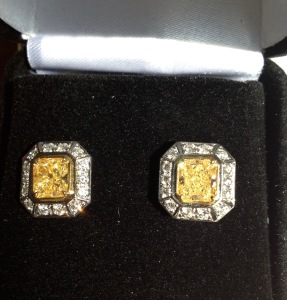Here’s how it happened. I once said it would be nice to have a yellow diamond, or as they’re now called, a fancy yellow diamond. I say a lot of things, but my husband heard this one. With no prompting from me, he decided I should have yellow diamond earrings, and asked a wholesale dealer to find a suitable pair, which he did, somewhere in Texas. My husband presented them to me on my next birthday, saying, ‘I’m sure you’ll want a different setting for these stones.’

There they are, at right—too dressy for my life, too big for my earlobes. The yellow diamonds, about three-quarters of a carat each, look yellower than they are because they’re backed with gold.
Tiny tutorial. Diamonds that are yellowish or brownish are graded as off-color white diamonds, like the family stones I wrote about here. But diamonds that are truly yellow, thanks to the presence of nitrogen atoms, are called fancy yellows. My Texas diamonds have a GIA certificate grading them as ‘fancy intense yellow’. The gold backing made them look ‘fancy vivid yellow,’ a more expensive color. I wanted them out of that setting. And I wanted to be able to look at them, in a ring.

When my husband bought the earrings, our wholesaler said, ‘I wish you needed a 1.5 carat emerald-cut white diamond, because I just took one in trade that’s a knockout, and I can give you a really great price.’ Those last four words were catnip to my husband. The stone was stunning, and he bought it.
So out of nowhere, I had the makings of a three-stone ring. I thanked my husband profusely and told him to please stop buying diamonds. (I meant it. He stopped.) And then I texted my jeweler friend Nan. The first thing she did was pop the yellow diamonds out of the earrings to see their actual color. ‘They’re buttery,’ she said. ‘I like them.’ From then on, they became The Butters.
How were we going to build this ring? Should the yellow diamonds be set vertically or horizontally? (The former, definitely.) And what metal would we use? I’d never thought about this, but yellow diamonds are usually set in yellow-gold prongs, while white diamonds are set in platinum ones—two metals in one ring. That would be fine, but it would look like a million other rings. ‘Couldn’t we forget about prongs and make a bezel setting,’ I asked? And thus began a major engineering project.
The challenge was to put three sizable stones into a chunky setting that wouldn’t overwhelm a small hand (mine). We envisioned it as having an Art Deco look, large yet graceful, like…like the S.S. Normandie. I swear we both thought of this.

When the Normandie first set sail in 1935, it was the largest passenger ship afloat—and the fastest. Slimmer and sleeker than other liners, with a bow like a clipper ship’s, it sliced through the water like a knife.

Its engines were powered by turbo-electric transmission, quieter and more maneuverable than steam turbines. Inside, it was a palace of Deco-Moderne style. Never mind that it came to a bad end. (It caught fire and capsized in 1942 while being refitted as a warship in New York.) It was a triumph of design.

The ship seems to have inspired the architect of a huge Deco apartment building in my neighborhood called The Normandy, left, built in 1938. It too is curvilinear, sizable yet sleek. But I digress. We’re talking about a three-stone ring.
To get the proportions right, Nan used CAD—computer-aided design. She worked with a designer who modeled the setting onscreen in three dimensions. The stones had to relate to each other properly and fit a small finger; this took many adjustments. Nan wanted the ring to have a handmade look, which most CAD pieces don’t. The neat thing was that she could print out a 3D model of the design to see how well it was working. She did this more than once. (I wrote about the CAD casting process here.)

The blue object above is a 3D model of the final design with the diamonds stuck in it. The two gold rings are slightly different 18K alloys offered by the casting company. They offer a lot of different alloys, and it took us a while to decide on the right one. Platinum? Yellow gold? Green gold? Brown gold? (There is such a thing.) In the end, we decided on a yellow gold that’s a favorite of Nan’s.
The setting was cast from the 3D model, and then it had to be finished. Until I met Nan, I didn’t know that finishing was a thing. But a casting has to be buffed and polished, the rough bits smoothed away and the desired finish achieved. This takes a pro. Nan’s finisher is a cranky guy—but he’s an artist. And then another artist, a setter, had to set the stones in the ring.

After nearly a year, the ring was done. Having seen it through the whole process, I could appreciate details that might otherwise have been lost on me: the way the two side stones are lower than the center stone, following the shape of the finger. The beveled corners that echo the shapes of the diamonds. And look at the sides: ‘shoulders’ that are rounded like the ship’s prow. Subtle, but important.
If we had commissioned a prong setting for these diamonds, it would have been perfectly fine. But this is jewelry of a higher order, a piece whose design I appreciate as much as the stones themselves.






It is a most beautiful ring. It will endure and remain beautiful far longer than us. And its story has only just begun…
LikeLike